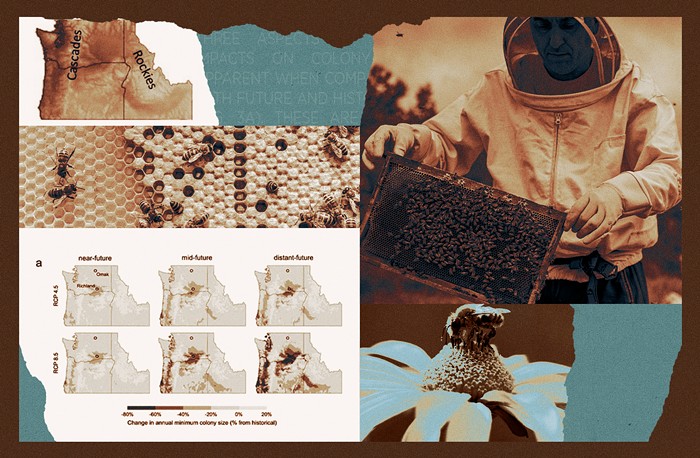
Spring has sprung, the grass has ris, and anyone wondering where the birdies is should look no further than your local fern gully.
With the arrival of nice weather, it’s time to get yourself an attractive plant or two — preferably one that can be enjoyed by native pollinators and other PNW creatures. Washington's plants and animals have co-evolved to appreciate each other, and you can contribute to the wellbeing of our local ecosystem and your own nesting impulses with a potted plant or two.
Of course, that’s easier said than done. (On one trip to a chain store a few years ago, I asked for native plants; the bewildered clerk handed me some sort of vine and said, “Here you go, this one’s native to Florida.”)
A lot of the advice for native gardeners presumes that you have a yard. “Obtain fifty cubic feet of mulch,” a guide might advise, or “rent an excavator so you can dig a hole for a mature maple.” Not helpful for those of us confined to tiny little urban apartments! But don’t worry — it’s still easy to grow local.
“There are a lot of things that do really well in containers or smaller spaces,” says Raymond J. Larson, who is (and please take a deep breath if you are reading this article out loud) curator of living collections and the Otis Douglas Hyde Herbarium at the University of Washington Botanic Gardens.
Although many think of towering fir trees when discussing native plants, small floral friends are available for apartment-dwellers. Larson recommends ferns, an excellent choice for various lighting conditions, and also for anyone wishing to recreate gay bars of the 1970s.
Consider, for example, the deer fern, which Larson describes as “architectural” in shape. Licorice fern is also a good choice — those are the weirdos you sometimes see clinging to the sides of maple trees. (See below for a complete list of Larson's recommended species, and visit GreatPlantPicks for tips on which ones go well together.)
Check out leathery polypodium as well, or the unfortunately-named maidenhair spleenwort, a very pretty plant that has the added benefit of making you seem interesting every time you tell people what it is.
“Those are great fern companions,” Larson says.
For flowers, look for fern lilies or the pacific coast iris, but don’t expect them to flower for long; blooms tend to be brief. The camas has a lovely purple stalk that is quite fleeting, trillium is a lovely white but also rather fragile, and fairybells have a nice downward-facing bloom.
If you have a little more space — say, a balcony with room for a bucket — an evergreen huckleberry makes a nice shrub, as does an Oregon grape or red flowering currant. These are not exactly beautiful berries; they look small, hard, and not quite as inviting as a strawberry. But they’re beloved by hummingbirds and other pretty neighbors, and they’re surprisingly tasty for human consumption if you can gather enough.
Larson notes that growing native species will yield benefits beyond just the plants. His home, north of the city, has a small yard with a mix of natives and exotics, and he works in the arboretum; as native species of plant flourish there, he’s seen more small animals arrive: “We’re starting to see the native Douglas squirrels move back,” he says, referring to the smaller, cuter version of the invasive eastern gray squirrels.
Songbirds and butterflies are likely to become interested in your plants as well. Larson says he no longer has to set out a birdfeeder; they simply come to investigate the plants that appeal to them.
Local small nurseries are your best bet for finding these plants — avoid QFC and Home Depot, which are more likely to have weird plants that don’t want to be here. City People, Sky Nursery, and Swansons can all help you find the right plant friend. City People is likely to be the easiest for Seattle dwellers to access via transit, or you can order by mail from Far Reaches Farm in Port Townsend. The Washington Native Plant Society maintains a list of other nurseries around the state.
Experts at those local shops will be able to point you in the right direction for a plant that matches your available space and sunlight. Whatever constraints you might have to endure, they’ll have something for you.
“Diversity is key,” Larson says, sounding like the host of an inspiring TikTok series that I would absolutely watch. “There’s a plant for every situation.”
More Recommended Native Plants for the Pacific Northwest
Raymond Larson was kind enough to send over a nice long list of native species that'll bring all the bees to the yard. Print this out/screenshot it on your phone to consult when you stop by the nursery.
Perennials, Ferns and Bulbs
Adiantum aleuticum, western maidenhair fern: deciduous but graceful in appearance, needs shade Asplenium trichomanes, maidenhair spleenwort: evergreen, compact, tolerant of sun or shade, great in containers Blechnum spicant, deer fern: evergreen, has an architectural form, best in shade or fine in sun with more water Camassia cusickii, Cusick's camas: bulb, brief but colorful blue blooms, best in small landscapes, tolerates wetter soils and sun, might be too coarse growing for pots Camassia quamash, great camas: bulb, brief but colorful blue blooms, best in small landscapes, tolerates wetter soils and sun, might be too coarse growing for pots Erythronium oregonum, giant white fawn lily: beautifully spotted leaves and pretty white flowers, ephemeral so it will disappear in summer but will come back next spring Erythronium revolutum, coast fawn lily/pink fawn lily: beautifully spotted leaves, pink flowers, ephemeral, so they'll disappear in summer but come back next spring Gymnocarpium disjunctum, common oak fern: small, spreading fern, good with other perennials, ferns, plants Iris tenax, tough-leaf iris: small stature blue/lavender/purple iris, good in part shade or sun and with other perennials Vancouveria hexandra, inside-out flower: durable evergreen perennial with unusual leaves, spring flowers are small and white, good groundcover and great with ferns and other woodlanders Smilacina racemosa: arching perennial to 3' with frothy white flowers in spring followed by orange berries, good for a small garden area, best in part shade, good in combination with other natives Trillium ovatum, our Seattle-native trillium: large white flowers in early spring that fade to pink, will disappear by late summer to return next year, good in combination with ferns and other perennials, slow to increase Polypodium glycyrrhiza, licorice fern: evergreen epiphyte on our native bigleaf maples but great in containers. Polypodium scouleri, leathery polypody/coast polypody: relative of licorice fern, but with bigger fronds, evergreen, great in containers by itself or with others Prosartes smithii, large-flowered fairy bells: best in part shade, attractive white bell-shaped flowers, followed by orange berries, favored by native pollinators, good in tandem with other perennials Shrubs
Ribes sanguineum, flowering currant: large shrub in time but good in containers, part sun to sun, white to pink flowers loved by hummingbirds Vaccinium ovatum, evergreen huckleberry: my go-to for great foliage, flowers and edible fruit; evergreen; durable, new leaves appear in bronze, red and light green; berries are very tasty to humans and wildlife; great in containers and good with other perennials; can be pruned to keep to smaller size; medium grower Mahonia nervosa, Cascade/low Oregon grape: yellow flowers in spring favored by hummingbirds, attractive blue-black fruits in summer, not very palatable but good for wildlife, good texture contrast with perennials and other shrubs, part sun to shade, slowly spreading evergreen, easily pruned Small Trees
Acer circinatum, vine maple: flowers attract pollinator in early spring, seeds provide food for squirrels and birds, great fall color, sun or shade Tsuga mertensiana, mountain hemlock: slow growing evergreen conifer, attractive blue-green foliage and compact habit in youth, dwarf varieties available, sun, part shade Chamaecyparis (syn. Cupressus/Xanthocyparis) nootkatensis, yellow cedar or Alaska cypress: For larger container or small landscapes, durable evergreen conifer with narrow profile, selections include 'Green Arrow' and 'Pendula', does well in containers for many years but ultimately will become a larger (though narrow) tree, slow/moderate growth, best in sun or part sun
















